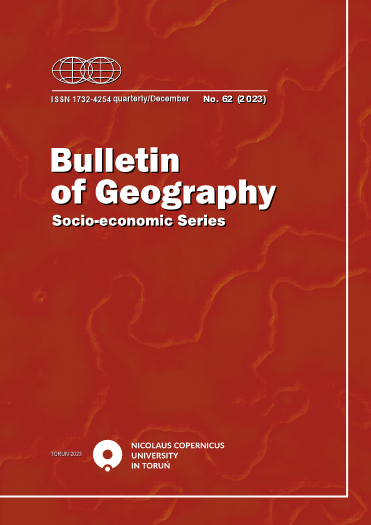What are the real populations of Chinese cities? On mistakes in city border defi nition and data interpretation in popular internet sources
DOI:
https://doi.org/10.12775/bgss-2023-0031Keywords
data analysis, Chinese population, population data comparison, China citiesAbstract
Economic growth and intensive metropolisation processes in the PRC have increased interest in information on the size of the country’s cities. Chinese institutions apply population data to administrative units which is considerably larger than its urban area. The publicly available data are often divergent; according to Gibson & Li (2017) hundreds of studies in economics misinterpret China’s subnational population and over 80% of articles use these data erroneously. Few specialists are able to use data directly from original Chinese sources (see Chan, 2007; Chan & Wan, 2017), most of them use publicly available sources. Scientists and other users often have at their disposal estimates published by international institutions. A comparative analysis of those data exposes marked dissimilarities. The article is to identify differences between particular sources and to establish their causes. I assume that the reason for the discrepancy in the assessment of the city's population is not a difference in method of defining the city, but rather the fact that the authors of the studies do not apply established criteria and do not provide accurate calculations. Finally, guidelines are created that, if followed, should result in smaller discrepancies between data published by various sources.
References
Cartier, C. (2015). Territorial Urbanization and the Party-State in China. Territory, Politics and Governance, 3(3): 294-320. DOI: https://doi.org/10.1080/21622671.2015.1005125.
Chan, K.W. (2007). Misconceptions and complexities in the study of China’s cities: Definitions, statistics, and implications. Eurasian Geography and Economics, 48(4): 383-412. DOI: https://doi.org/10.2747/1538-7216.48.4.383.
Chan, K.W. (2015). Five Decades of the Chinese Hukou System. In: Handbook of Chinese Migration: Identity and Wellbeing, 23-47, Edward Elgar Publishing, Inc.: Northampton, MA.
Chan, K.W. & Hu, Y. (2003). Urbanization in China in the 1990s: New Definition, Different Series, and Revised Trends. The China Review, 3(2): 49-71.
Chan, K.W. & Wan, G. (2017). The size distribution and growth pattern of cities in China, 1982–2010: analysis and policy implications. Journal of the Asia Pacific Economy, 22(1): 136-155. DOI: https://doi.org/10.1080/13547860.2016.1266829.
Chien, S-S. (2010). Prefectures and prefecture-level cities: the political economy of administrative restructuring. In: Chung J. H., Lam, T-C. (Eds.). China’s Local Administration. Traditions and changes in the sub-national hierarchy, 127-148). Routledge: New York, NY.
Gibson, J. & Li, C. (2017). The Erroneous Use of China's Population and Per Capita Data: a Structured Review and Critical Test. Journal of Economic Surveys, 31(4): 905-922. DOI: 10.1111/joes.12178.
Kamal-Chaoui, L., Leeman, E. & Rufei, Z. (2009). Urban Trends and Policy in China, OECD Regional Development Working Papers 2009/1, OECD Publishing. DOI: 10.1787/225205036417.
Kirkby, R.J. (1985). Urbanization in China: Town and Country in a Developing Economy 1949–2000 A.D., Columbia University Press: New York, NY.
Kroeber, A.R. (2016). China's Economy: What Everyone Needs to Know?, Oxford University Press.
Lu, D. (2012). The Great Urbanization of China, Series on contemporary China, 30, World Scientific Publishing: Singapore.
Maik, W. (1997). Podstawy geografii miast (Basics of city geography – in Polish). UMK: Toruń.
Miller, T. (2012). China's Urban Billion: The Story behind the Biggest Migration in Human History, Zed Books: London-New York. DOI: 10.1007/s11366-015-9379-6.
Pannell, C.W. (2003). China’s Demographic and Urban Trends for the 21st Century. Eurasian Geography and Economics, 44(7): 479–496. DOI: https://doi.org/10.2747/1538-7216.44.7.479.
Shen, J. (2005). Counting urban population in Chinese censuses 1953–2000: changing definitions, problems and solutions. Population, Space and Place, 11(5): 381-400. DOI: https://doi.org/10.1002/psp.382.
Shen, J. (2006). Estimating Urbanization Levels in Chinese Provinces in 1982–2000. International Statistical Review, 74(1): 89–107. DOI: https://doi.org/10.1111/j.1751-5823.2006.tb00163.x.
Sokołowski, D. (1998). Niektóre problemy definiowania pojęć geograficzno-osadniczych związanych z urbanizacją (Some problems of defining geographical notions related to urbanisation processes – in Polish). Czasopismo Geograficzne, 69(2): 169-192. DOI: https://doi.org/10.5281/zenodo.1146842.
Szymańska, D. (2007). Urbanizacja na świecie (Urbanization in the world – in Polish). PWN: Warszawa.
Wang, X-R., Hui, E.C., Choguill, C. & Jia, S-H. (2015). The New Urbanization Policy in China: Which Way Forward. Habitat International, 47: 279–284. DOI: http://hdl.handle.net/10397/27398.
Young, J. (2013). China's Hukou System: Markets, Migrants and Institutional Change, Palgrave Macmillan: Basingstoke. DOI: 10.1057/9781137277312.
Zhou, Y. & Ma, L.C.J. (2003). China’s Urbanization Levels: Reconstructing a Baseline from the Fifth Population Census. The China Quarterly, 173: 176-196.
Zhou, Y. & Ma, L.C.J. (2005). China’s Urban Population Statistics: A Critical Evaluation. Eurasian Geography and Economics, 46(4): 272–289. DOI: https://doi.org/10.2747/1538-7216.46.4.272.
Zhou, Y. & Shi, Y.S. (1995). Jianli zhongguo chengshi de shiti diyu gainian (Toward Establishing the Concept of Physical Urban Area in China - in Chinese). Dili xuebao (Acta Geographica Sinica), 50(4): 289–301.
Main sources
United Nations, Department of Economic and Social Affairs, Population Division (2018). World Urbanization Prospects: The 2018 Revision, Online Edition. Available at: https://population.un.org/wup/Download [File 12: Population of Urban Agglomerations with 300,000 Inhabitants or More in 2018, by country, 1950-2035 (thousands)].
World Population Review. Available at: http://worldpopulationreview.com/countries/china-population/cities/ and https://www.worldometers.info/demographics/china-demographics/#urb.
Wendell Cox, Demographia World Urban Areas. 10-18th Annual Editions (PDF). (St. Louis: Demographia, 2014-2022). Available at: http://www.demographia.com/.
Thomas Brinkhoff: China, Available at: https://www.citypopulation.de/en/china/.
PopulationData.net, https://www.populationdata.net/pays/chine/aires-urbaines.
PopulationStat. World statistical data, https://populationstat.com/china/.
World Gazetteer, http://world-gazetteer.com (Retrieved 2004-10-10, 2010-12-18].
Downloads
Published
How to Cite
Issue
Section
License
Copyright (c) 2023 Dariusz Sokołowski

This work is licensed under a Creative Commons Attribution-NonCommercial-NoDerivatives 4.0 International License.
Title, logo and layout of journal Bulletin of Geography. Socio-economic Series are reserved trademarks of Bulletin of Geography. Socio-economic Series.Stats
Number of views and downloads: 873
Number of citations: 0



